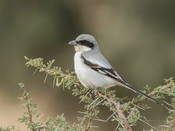search
classification
|
basic information
|
Great Grey Shrike
Lanius excubitor (Linnaeus, 1758)

|

|
|
|
2014-07-23
Kosikha, Kosikhinskiy rayon, Altayskiy kray |
© Evgeniy Boginskiy
|
|
Description
On adult male of the Great Grey Shrike the crown, mantle and uppertail are grey (from pale-grey to brownish-grey). The black mask extends from the bill base across the eyes to ear coverts. The flight feathers are black but some of them have white bases forming large or little or divided on two parts speculum. The tail feathers are black with white terminal patches which become broader to the tail-sides. Sometimes two or three outer pairs of tail feathers may be white. The throat, breast, abdomen, flanks and undertail are off-white, grey or brownish-grey; in last case with dark scaly pattern. The adult females are same colored but all tones are dimmer and greyer; underparts always have obvious brownish scaly pattern. Some females (probably old) are not distinguished from males. Juveniles are similar on females but more greyer; the scaly pattern is more expressive not only on underparts but on the head and mantle too. The bill and legs are black, eyes are dark-brown. Weight 54.5-88.6 grams, males - wing 102.0-123.0, tail 105.0-125.0, females – wing 104.0-115.5, tail 105.0-130.0 mm.
Biology
The Great Grey Shrike is rare resident. It inhabits the upper part of light spruce forest of Dzhungarskiy Alatau at 2500-2700 m above sea level and sub-alpine zone with the odd tree or shrub in Altai (at 2000- 2500 m). It occurs on passage and in winter in open areas with single trees, groves, shrubby thickets and forest edge. There is no data about its breeding biology in Kazakhstan. Fledged juveniles had been observed on July 17 in 1966 in Altai near Markakol' lake. In foothills and on plains appear singly in October. Spring movement begins in early March to early April in southern areas, and in early to mid of April in northern areas, being recorded up to the end of May. Great Grey Shrike is an active bird of prey, living on small rodents and birds, afmphibia and reptiles, as well as larger insects. It can catch small birds on the wing killing them with a bite through the occiput. The prey can be carried either in beak or in clutches.
References












